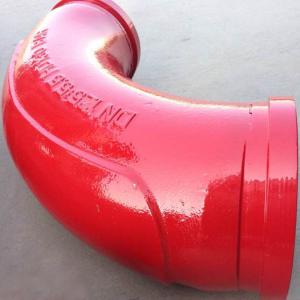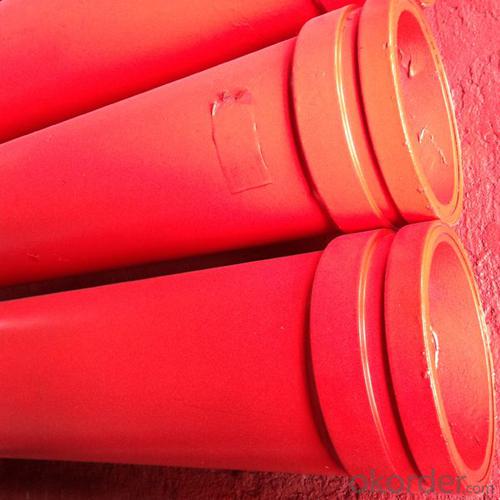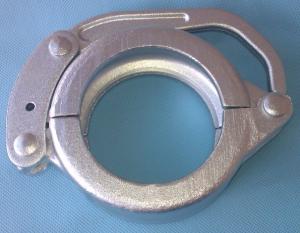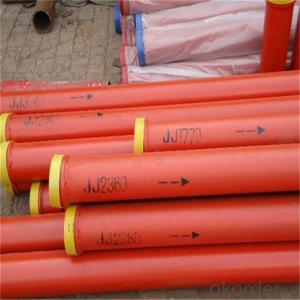Concrete Pumps Spare Parts Delivery Pipe Elbow Clamp Rubber Hose
- Loading Port:
- Tianjin
- Payment Terms:
- TT or LC
- Min Order Qty:
- 100 pc
- Supply Capability:
- 1000 pc/month
OKorder Service Pledge
OKorder Financial Service
You Might Also Like
Product Description:
About concrete spare parts, we can supply PM, Schwing, Sany and Zoomlion parts. Delivery pipes single wall and double wall
, casting elbows and twin elbows, forged clamps, welding flanges, rubber end hoses, clearning parts etc.
Casting Elbows
Description | Remark |
Elbow DN125 R275 15°148mm | Manganese |
Elbow DN125 R275 20°148mm | Manganese |
Elbow DN125 R275 30°148mm | Manganese |
Elbow with EXT R275 45° | Manganese |
Elbow with EXT R275 90° | Manganese |
Elbow DN125 R275 90°148mm | PM |
Elbow DN125 R275 90°148mm | Double Neck |
Elbow DN125 R275 90°148mm | Schwing |
Elbow DN125 R180 90°148mm | Manganese |
Elbow DN100 R275 45°127mm | Manganese |
Elbow DN100 R275 45°132mm | Manganese |
Elbow DN100 R175 45°127mm | Manganese |
Elbow DN100 R275 45°114.3mm | Manganese |
Elbow DN100 R275 90°114.3mm | Manganese |
Elbow DN100 R275 90°127mm | Manganese |
Elbow DN100 R275 90°132mm | Manganese |
Elbow DN100 R180 90°127mm | Manganese |
Elbow DN100 R285 90°127mm | Manganese |
Elbow DN100 R152.4 90°127mm | Manganese |
Elbow DN100 R281 90°142mm | Manganese |
Twin Elbows
Description | Remark |
Elbow DN125 R275 90°148mm | Twin layer |
Elbow with EXT R275 90° | Twin layer |
Elbow DN125 R275 45°148mm | Twin layer |
Elbow DN125 R275 36°148mm | Twin layer |
Elbow DN125 R275 30°148mm | Twin layer |
Elbow DN125 R275 20°148mm | Twin layer |
Elbow DN125 R275 15°148mm | Twin layer |
Elbow DN125 R275 10°148mm | Twin layer |
Reducing Elbows
Description | Remark |
Reducing Elbow DN125/DN100 90°148mm/127mm | Manganese |
Reducing Elbow DN125/DN100 90° 148mm/122mm | Manganese |
Reducing Elbow DN125/DN100 90° 157mm/131.5mm | Manganese |
Reducing Elbow DN125/DN75 90°157mm/106mm | Manganese |
Reducing Elbow DN125/DN75 90°148mm/88.9mm | Manganese |
Reducing Elbow DN100/DN75 90° 127mm/97mm(127/88.9 131/106)mm | Manganese |
Pipes and Long Bends
Description | Remark |
Delivery Pipe DN125-3 MTR | Thick 3.2mm Q235 |
Delivery Pipe DN125-3 MTR | Thick 4.1mm St.52 |
Delivery Pipe DN125-3 MTR | Thick 4.5mm St.52 |
Delivery Pipe DN125-3 MTR ZX | Thick 7.1mm |
Delivery Pipe DN125-6 MTR w/o Flanges | Thick 4.1mm St.52 |
Delivery pipe DN125-6 MTR w/o Flanges | Thick 4.5mm St.52 |
Hardened Pipe DN125-3 MTR | Thick 4.5mm |
Twin wall pipes DN125-3 MTR | Thick 2.5mm+2mm |
Description | Remark |
Long Bend DN125 R500 45° | St.52 |
Long Bend DN125 R500 90° | St.52 |
Long Bend DN125 R1000 45° | St.52 |
Long Bend DN125 R1000 90° | St.52 |
Long Bend DN125 R500 45° | ZX |
Bend DN125 R500 90° | ZX |
Bend DN125 R1000 45° | ZX |
Bend DN125 R1000 90° | ZX |
Rubber End Hoses
Description | Remark |
4 MTR Rubber Hose DN100 2 Side Flange | W. P 85 Bar/1230PSI |
3 MTR Rubber Hose DN125 1 Side Flange | W. P 85 Bar/1230PSI |
3 MTR Rubber Hose DN125 2 Side Flange | W. P 85 Bar/1230PSI |
4 MTR Rubber Hose DN125 1 Side Flange | W. P 85 Bar/1230PSI |
4 MTR Rubber Hose DN125 2 Side Flange | W. P 85 Bar/1230PSI |
5 MTR Rubber Hose DN125 1 Side Flange | W. P 85 Bar/1230PSI |
5 MTR Rubber Hose DN125 2 Side Flange | W. P 85 Bar/1230PSI |
6 Meter Rubber Hose DN125 2 Side Flange | W. P 85 Bar/1230PSI |
Rubber Seal DN125 |
Cleaning Parts and Seals
Description | Remark |
Cleaning Ball (Medium) | DN150 |
Cleaning Ball (Hard) | DN150 |
Cleaning Ball (Medium) | DN125 |
Cleaning Ball (Hard) | DN125 |
Cleaning Ball (Medium) | DN100 |
Cleaning Ball (Hard) | DN100 |
Couplings
Description | Remark |
Snap Coupling DN125 |
|
Bolt Coupling DN125 | Forged |
Screw Coupling DN125 |
|
Mounting Coupling DN125 | For Flange 157mm |
Wedge Coupling DN125 |
Product Images:







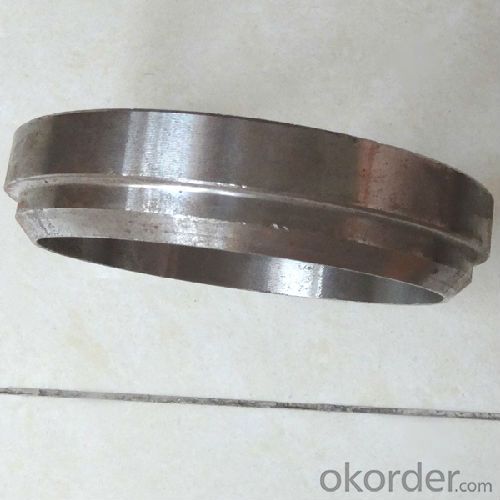

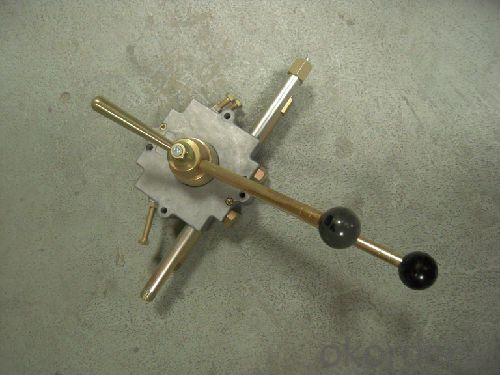


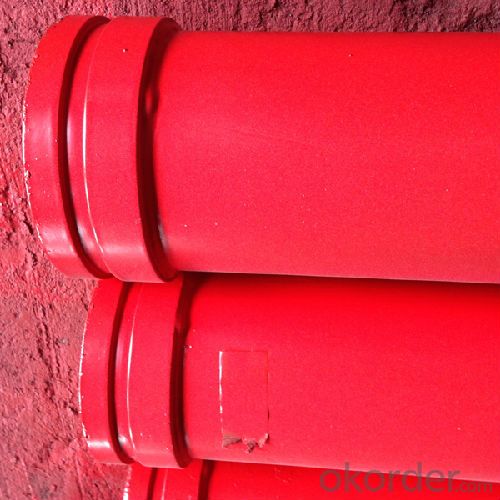



FAQ:
Q1: Why buy Materials & Equipment from OKorder.com?
A1: All products offered by OKorder.com are carefully selected from China's most reliable manufacturing enterprises. Through its ISO certifications, OKorder.com adheres to the highest standards and a commitment to supply chain safety and customer satisfaction.
Q2: How do we guarantee the quality of our products?
A2: We have established an advanced quality management system which conducts strict quality tests at every step, from raw materials to the final product. At the same time, we provide extensive follow-up service assurances as required.
- Q: How can one differentiate between genuine and counterfeit concrete pump spare parts?
- Differentiating between genuine and counterfeit concrete pump spare parts can be a challenging task, but there are several ways to ensure you are purchasing authentic components. Here are some strategies to consider: 1. Research the Manufacturer: Start by conducting thorough research on the manufacturer of the concrete pump spare parts. Look for reputable and established companies with a proven track record. Check their website, read customer reviews, and analyze their industry standing. Genuine manufacturers usually have a strong online presence and provide detailed information about their products. 2. Verify the Supplier: When purchasing spare parts, it is crucial to choose a reliable and authorized supplier. Make sure the supplier has a good reputation in the industry and has been in the business for an extended period. Authorized distributors often have a direct relationship with the manufacturer and can provide genuine parts. 3. Inspect Product Packaging: Genuine concrete pump spare parts often have specific packaging that includes branding, logos, and detailed product information. Counterfeit products may have poor quality packaging or contain misspellings, incorrect logos, or inconsistent color schemes. Examine the packaging closely to determine its authenticity. 4. Check Product Quality and Finish: Counterfeit parts are often made from low-quality materials and lack the precision and finish of genuine parts. Inspect the spare parts for any signs of poor workmanship, rough edges, or uneven surfaces. Genuine parts are usually well-crafted and undergo strict quality control measures. 5. Compare Prices: Be cautious of significantly lower prices for spare parts, as it could be an indication of counterfeit products. Counterfeiters often sell their goods at a lower price to attract customers, but the quality and performance may be compromised. Compare prices with other suppliers to ensure they are within the expected range. 6. Seek Expert Advice: If you're uncertain about the authenticity of concrete pump spare parts, consult with industry experts or experienced professionals. They can guide you in identifying genuine components and help you make informed decisions. 7. Request Certifications and Documentation: Genuine manufacturers provide certifications and documentation, such as ISO certifications or test reports, to validate the quality and authenticity of their products. Ask the supplier for these documents and verify their legitimacy with the manufacturer if necessary. Remember, purchasing genuine concrete pump spare parts is essential for the safety and efficiency of your equipment. By following these steps and exercising caution, you can minimize the risk of buying counterfeit components and ensure the longevity and reliable performance of your concrete pump.
- Q: Can concrete pump spare parts be heat-treated or hardened for increased durability?
- Yes, concrete pump spare parts can be heat-treated or hardened for increased durability. Heat treatment involves subjecting the parts to controlled heating and cooling processes to alter their mechanical properties. This can significantly improve their hardness, strength, and wear resistance, making them more durable and capable of withstanding harsh operating conditions. Heat treatment methods such as quenching and tempering, induction hardening, and case hardening can be applied to different types of spare parts, including cylinders, pistons, wear plates, and delivery pipes. These processes help to enhance the overall performance and lifespan of the spare parts, ensuring they can withstand the demanding nature of concrete pumping operations.
- Q: What are the specifications for concrete delivery pumps?
- The pressure of each safety valve of the hydraulic system of concrete pump shall comply with the requirements of the manual, and the user shall not adjust the change
- Q: How can I minimize downtime during the replacement of concrete pump spare parts?
- To minimize downtime during the replacement of concrete pump spare parts, it is crucial to follow a few key steps. First, ensure that you have a comprehensive understanding of the specific spare parts required for your concrete pump. This will help you streamline the ordering process and minimize delays. Additionally, it is essential to schedule regular maintenance and inspections to identify any potential issues beforehand, allowing you to proactively replace parts before they fail. Lastly, work with a reputable supplier who can provide high-quality spare parts promptly, reducing downtime.
- Q: What are the different types of concrete pump hydraulic pumps?
- There are two main types of concrete pump hydraulic pumps: the piston pump and the gear pump. The piston pump uses reciprocating pistons to generate pressure and move the concrete, while the gear pump uses rotating gears to pump the concrete. Both types have their own advantages and are suitable for different applications.
- Q: What is the purpose of a concrete pump hopper grate?
- The purpose of a concrete pump hopper grate is to prevent large debris or foreign objects from entering the pump and potentially causing damage or blockages. The grate acts as a filter, allowing only smaller particles and liquid concrete to pass through while blocking larger materials such as rocks, wood, or other debris. This helps to maintain the efficiency and functionality of the pump, ensuring a smooth and uninterrupted flow of concrete. Additionally, the grate also helps to protect the pump's internal components, such as the impeller and valves, from potential damage caused by large objects. Overall, the concrete pump hopper grate plays a crucial role in maintaining the quality and reliability of the pumping process, preventing potential issues and ensuring a successful concrete placement.
- Q: What is the importance of a good quality concrete pump seal?
- There are several reasons why a high-quality concrete pump seal is of utmost importance. Firstly, it guarantees the efficient and dependable operation of the concrete pump. The seal's main responsibility is to prevent any leakage or loss of pressure during the pumping process, which can cause delays, inefficiencies, and even damage to the pump itself. Furthermore, a top-notch seal helps to maintain the integrity of the concrete being pumped. Concrete is composed of various materials, including water, cement, aggregates, and additives. To achieve the desired strength and durability, it is essential that the concrete remains in its optimal state without any contamination or dilution. A superior seal effectively blocks any external elements, such as water or air, from entering the pumping system and affecting the composition of the concrete. Moreover, a reliable seal contributes to the safety of the pumping operation. Construction sites often utilize concrete pumps, where workers and equipment are present. Any failure or malfunction of the seal can result in unexpected incidents, injuries, or damage to property. Therefore, investing in a high-quality seal provides peace of mind and reduces the risk of accidents. Lastly, investing in a top-quality concrete pump seal can lead to significant time and cost savings in the long run. A durable and efficient seal minimizes the need for frequent replacements or repairs, reducing maintenance costs and downtime. It also ensures a smooth and uninterrupted pumping process, allowing construction projects to be completed more efficiently and on schedule. In conclusion, prioritizing the selection and installation of a reliable concrete pump seal is crucial for ensuring the efficient operation, integrity of the concrete, safety, and cost-effectiveness of a pumping project. Therefore, it is essential to give utmost importance to choosing a high-quality seal to guarantee the success and longevity of concrete pumping projects.
- Q: What is the purpose of a concrete pump cylinder?
- The purpose of a concrete pump cylinder is to provide the necessary pressure and force to push the concrete mixture through the pumping system and into the desired location, allowing for efficient and precise placement of concrete in construction projects.
- Q: What is the function of a concrete pump hydraulic motor?
- The function of a concrete pump hydraulic motor is to provide the necessary power and motion to operate the pumping mechanism of the concrete pump.
- Q: What is the role of a concrete pump hopper agitator shaft?
- To ensure consistent and uniform mixing of concrete in the hopper, the concrete pump hopper agitator shaft is responsible. It is equipped with paddles or blades that rotate within the hopper, effectively stirring the concrete and preventing it from settling or separating. This maintains the desired fluidity and consistency of the concrete, allowing for smooth and efficient pumping without any blockages. Additionally, the agitator shaft helps to remove any hardened or stuck concrete, ensuring that the hopper remains clean and obstruction-free. Ultimately, the agitator shaft plays a vital role in keeping the concrete well-mixed and ready for pumping, thereby improving the performance and productivity of the concrete pump.
Send your message to us
Concrete Pumps Spare Parts Delivery Pipe Elbow Clamp Rubber Hose
- Loading Port:
- Tianjin
- Payment Terms:
- TT or LC
- Min Order Qty:
- 100 pc
- Supply Capability:
- 1000 pc/month
OKorder Service Pledge
OKorder Financial Service
Similar products
Hot products
Hot Searches
Related keywords

